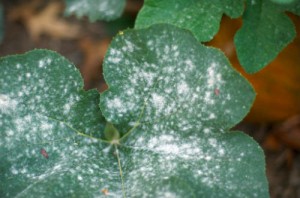Organic Gardening 101: How to Prevent Powdery Mildew
September 3-2013
A turn of the knob and a push of the backdoor reveals a late summer rainstorm has retreated from a perfect gleaming sun high in an unblemished sky. The array of flora calls to you as your bare feet move through a moist warming field. As you grin to mother nature for quenching the thirst of your precious food source the corners of your lips begin to drop as your produce ebbs into sight. You cringe as the hazy air reveals perishing vines screaming for aid. Vines are wilting, leaves are becoming spotted with burnt yellow and pale olive green. The succulent squashes, melons, and cucumbers seem to be stunted and rotting. As you clutch your weeping plants in dismay your frustration pounds at your brain asking “How could this happen?!” Just a day or two prior the leaves were lushly deep green, the vines taught and sturdy, and the blossoms plentiful.
If this sounds familiar you know how devastating powdery mildew can be to the seemingly healthiest gardens. Alas! There are many organic solutions to beat this pesty fungus. Just like any infection flora and fauna alike, the best solution is preventative. Yet, it is seldom too late to save plants once infected with mildew if a watchful eye is kept and a small amount of time utilized.
Many veterans of the organic garden will exclaim that you are going to get mildew no matter what. This is downright erroneous. The best preventative measure to practice is the utilization of Neem oil long before any sign of infection. To understand why Neem oil works you must understand how mildew and most fungi multiply and spread. Consider an ideal environment for fungus to thrive. Aside from breathing, it must meet two criteria: adequate warmth to energize its growth and adequate moisture to feed off of. Controlling the first, respectively, would hinder the growth of your plants. Controlling the latter is the key to success.
Neem oil is 100 percent organic as it is a simple oil pressed from the fruit and seeds of Azadirachta Indica evergreen trees which are found primarily in India. It is rich in Omega 3, 6, and 9 fatty acids as well as Palmitic and Stearic acids. Though fungus prefers a slightly acidic pH which these fatty acids provide, it is the hydrophobic nature of Neem oil that we are interested in. Hydrophobicity is a chemistry term which refers to non-polar or neutral molecules repelling the polarity of water, in other words it’s non-soluble and tends to stick together. We have all seen this in the kitchen when melted butter or oil refuses to mix with water.
Powdery Mildew attacks every square inch of the plants surface area above the ground. Since it is not imperative that water enters through the leaves the focus is on keeping this part as dry as possible. Drip irrigation should be utilized whenever possible. If a thin, even layer of Neem oil is applied to the parts of the plant which are exposed to rainfall then moisture will simply bead and fall off keeping the protected leaves and vines free of moisture. Though it will not mix with rain water, an intense downpour will rinse enough Neem oil off to make the plant susceptible to infection. This makes it necessary to reapply every 7-14 days especially after heavy rainfall.
It is important not to shock or suffocate your plants with too much Neem oil. A good rule of thumb is about one teaspoon per half gallon of water. A small amount goes a long way. The best way is to use a simply spray bottle which allows you to saturate every part of the plant without wasting too much oil. Don’t forget to cover the underside of the leaves and the stalks or vines where the infection generally originates. If shaking your spray bottle vigorously after every few sprays doesn’t thrill you an emulsifier such as liquid soap may be used in a proportion of about one teaspoon per gallon of solution. Once soap is added to the cocktail you must use it within eight hours for best results. Timing is also important as the wet applied oil will accelerate photons from the midday sun causing leaves to turn yellow and die from a burn. The best time to apply is very early in the morning or very late in the afternoon. Applying between ten a.m. and two p.m. will undoubtedly damage your plants.
It is wise to find 100% Neem oil which you may have to resort to the internet for. Premixed solutions are available but are extremely expensive for what you get. A premixed 32 ounce bottle can easily run you seven dollars and contain less than 1% Neem oil. This is not the only organic way to prevent mildew but consistently resonates as the most effective method.
Some other solutions are raising the pH of the plant by spraying its entirety with a basic solution such as milk or baking soda. Theoretically any base can be used as long as it is not so harsh that it damages the plant. Another method uses lady bugs which naturally eat the mildew when they run out of aphids. You can order lady bugs online or attract them with a specific nectar. Oppositely cucumber beetles have been known to spread the disease therefore a bird feeder next to your garden may be beneficial at attracting their natural predators. Most birds will not eat lady bugs due to their unpleasant taste hence the beauty of ecology.
In conclusion, the best defense against mildew is proactive, not reactive. A combination of remedies will yield the best results. Make sure you have lady bugs present, place a bird feeder next to your garden to control disease spreading bugs, and keep a bit of Neem Oil on your susceptible plants at all times.
